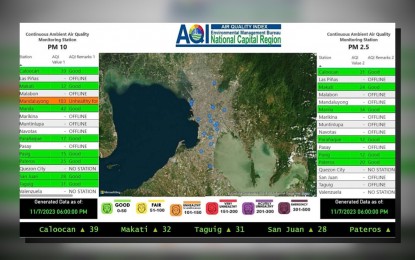
AIR QUALITY. The monitoring of the Department of Environment and Natural Resources-Environmental Management Bureau shows air quality improved during the first half of 2023. Among the factors in the improvement are changes in fuel emission standards for motor vehicles and increased use of biofuels. (Screenshot from the DENR-EMB website)
MANILA – A general improvement in the country’s air quality was recorded by the Department of Environment and Natural Resources-Environmental Management Bureau (DENR-EMB) from January to June 2023.
In a news release issued on Tuesday, the DENR said the improved air quality was based on the amount of particulate matter (PM) in the atmosphere.
PM comes in many different sizes, with larger particles coming mostly from soils, while smaller particles come from the burning of fossil fuels, like gasoline in cars, diesel in trucks, and coal used by power plants.
The DENR said the EMB recorded a decrease in PM10 in Metro Manila, and a slight increase nationwide.
PM10 are microscopic matter suspended in the air that are 10 micrometers or less such as dust from paved and unpaved roadways.
While some of these particles can be filtered by the body, these can irritate the eyes, nose and throat.
The 24-hour acceptable threshold standard level or guideline value for PM10 is 150 ug/ncm (micrograms per normal cubic meter) while the annual guideline value is 60 ug/ncm.
DENR Assistant Secretary and EMB Director Gilbert Gonzales noted that the volume of air pollutants in Metro Manila have significantly decreased over the past decade when PM10 was averaging as high as 70 ug/ncm in 2012, and PM2.5 at 36 ug/ncm in 2017.
“The improvement in air quality can be attributed to a number of factors such as changes in fuel emission standards for motor vehicles, increased use of bio-fuels and tighter monitoring of emissions from factories and other industrial facilities,” Gonzales said.
In Metro Manila, PM10 averaged 40 ug/ncm from January to June 2023, which is slightly below the 43 ug/ncm posted in the same period in 2022.
Nationwide, the average amount of PM10 was at 34 ug/ncm for the first six months of 2023, higher than the 29 ug/ncm posted in the same period last year.
The DENR-EMB has a total of 134 air quality monitoring stations nationwide with capacity to monitor ambient air quality by measuring air pollutants PM10 and PM2.5, as well as levels of carbon monoxide, nitrogen oxide and sulfur oxide
Meanwhile, for the first semester of 2023, PM2.5 in Metro Manila averaged 20 ug/ncm, still below the average 23 ug/ncm in the same period in 2022, and 18 ug/ncm nationwide, which is slightly higher than the 16 ug/ncm posted in the first half of 2022.
“PM2.5 are particles that are 2.5 micrometers or less and can enter the lungs and the bloodstream. These originate from direct emissions into the atmosphere, such as forest fires, or the mixing of gases from factories, industries, and motor vehicles. The annual guideline value or threshold for PM2.5 is set at 25 ug/ncm while the 24-hour guideline value is 35 ug/ncm,” the DENR said.
Gonzales said the biggest contributor of air pollutants were motor vehicles.
“In Metro Manila, concentrations for PM10 and PM2.5 peak and even exceed threshold limits for ground-level ambient air quality when traffic becomes heavy in major thoroughfares. But air quality varies depending on location, time, and weather conditions. It changes over time,” he added.
Based on DENR Administrative Order No. 2013-13, the acceptable limit for PM 2.5 is 50 ug/Ncm for the short term 24-hour average level, and 35 µg/Ncm for the long term one-year average level. (PNA)
